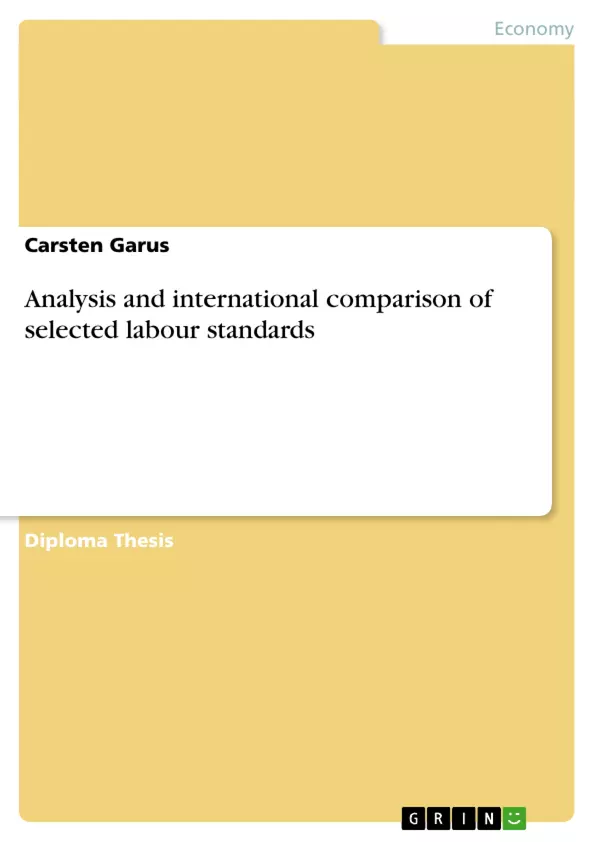We view workers as trying to find the best possible job and assume that most firms are trying
to make money. Workers and firms, therefore, enter the labour market with different
objectives- workers are often trying to sell their labour at the highest price, whereas firms are
often trying to buy labour at the lowest cost.
But this relationship between workers and firms involves much more than the exchange of a
worker’s labour service for the payment of an hourly or monthly wage. Labour standards that
guarantee appropriate working conditions and various forms of insurances1 which protect
workers are also provided as part of the employment relationship in most countries.2
As a result of this, the employment relationship, which is one of the most fundamental
relationships in our lives, attracts a good deal of legislative attention.
Wages and other terms of employment are not determined solely through market dealings
between workers and employers. The types of economic exchanges that can occur between
workers and firms are often limited by the set of basic rules that the government has enacted
to regulate transactions in the labour market.
Therefore, three leading actors are in the labour market: workers, represented by labour
unions, firms and the government.
Labour standards, which can be defined as “norms and rules that govern working conditions
and industrial relations”3, should cover most workers and workplaces, and represent the
minimum labour rights to which employees are entitled—a ground floor below which
employers cannot go. They include issues such as the minimum wage, maximum hours of
work, overtime pay, maternity leave, statutory holidays—in essence, an array of labour laws
that allow workers to better balance work and family, protect their personal time, and earn a
decent living under reasonable conditions.
In recognition of the fact that the relationship between a worker and an employer is not
always an equal one, labour standards represent a collective agreement society negotiates on
behalf of all workers.4 [...]
1 These insurances include, for example, unemployment, health care, and retirement income insurances (pensions).
2 According to Ronald G. Ehrenberg (1994), p. 5
3 According to the OECD (1996b), p. 25
4 “It is easier for an employer to replace recalcitrant workers than for employees to “replace” a recalcitrant employer,
especially when unemployment is high” (Stiglitz, 2001).
Inhaltsverzeichnis (Table of Contents)
- Initial Consideration
- Definition
- Main Objective and Structure
- Countries
- Globalisation
- Trade Unions
- Multinational Enterprises
- International Organisations
- International Labour Organisation
- Core Labour Standards
- Freedom of Association
- Discrimination
- Forced Labour
- Child Labour
- Ratification
- Economic Efficiency and Core Labour Standards
- Equilibrium without distortions
- Core Labour Standards and the allocation of production factors
- Economic Efficiency and Employment Discrimination
- Economic Efficiency and Forced Labour
- Economic Efficiency and Child Labour Exploitation
- Economic Efficiency and Freedom of Association
- Other Standards
- Social Security
- Unemployment Insurance
- Hours of Work
- Minimum Wage
- Social Security
- Other reasons for adopting labour standards
- Scissor-shaped labour supply curve
- Public Goods
- Externalities
- Foreign Trade
- Core Labour Standards and Trade
- Foreign Direct Investment and Labour Standards
- Labour Standards in Special Processing Zones
- Sanctions
- Labelling
- Costs
- Ehrenberg Model
- Productivity
- Conclusion
- The Future of Labour Standards
Zielsetzung und Themenschwerpunkte (Objectives and Key Themes)
This dissertation analyzes and compares selected labour standards internationally. It explores the role of labour standards in the context of globalization, trade unions, multinational enterprises, and international organizations.
- Definition and interpretation of labor standards
- Economic efficiency and its relationship to core labor standards
- The impact of globalization and international trade on labor standards
- The role of international organizations in promoting and enforcing labor standards
- Cost implications and future prospects of labor standards
Zusammenfassung der Kapitel (Chapter Summaries)
- Initial Consideration: This chapter introduces the concept of labour standards, defining them as rules governing working conditions and industrial relations. It highlights the role of labour standards in balancing the relationship between workers and firms, emphasizing the need for a fair playing field and predictable business conditions.
- Countries: This chapter discusses the impact of globalization, trade unions, multinational enterprises, and international organizations on labour standards. It focuses particularly on the role of the International Labour Organisation (ILO) in setting international standards.
- Core Labour Standards: This chapter examines key core labour standards, including freedom of association, discrimination, forced labour, and child labour. It discusses the ratification process of these standards by countries.
- Economic Efficiency and Core Labour Standards: This chapter analyzes the potential impact of core labour standards on economic efficiency. It explores the theoretical arguments and empirical evidence regarding the relationship between labour standards and economic performance.
- Other Standards: This chapter examines additional labour standards beyond the core standards, including social security, hours of work, and minimum wage. It discusses the rationale and potential benefits of these standards.
- Other Reasons for Adopting Labour Standards: This chapter explores reasons beyond economic efficiency for adopting labour standards, including the concept of "scissor-shaped labour supply curve" and the role of labour standards as public goods.
- Foreign Trade: This chapter examines the relationship between labour standards and foreign trade, including the impact of trade agreements, foreign direct investment, and sanctions.
- Costs: This chapter discusses the costs associated with adopting labour standards. It examines models, such as the Ehrenberg Model, and analyzes the potential impact of labour standards on productivity.
Schlüsselwörter (Keywords)
This dissertation focuses on the analysis and international comparison of selected labour standards, particularly core labour standards, economic efficiency, globalization, trade unions, multinational enterprises, international organizations, and the International Labour Organisation (ILO).
- Quote paper
- Carsten Garus (Author), 2003, Analysis and international comparison of selected labour standards, Munich, GRIN Verlag, https://www.grin.com/document/24366



